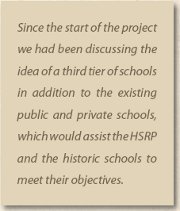HSRP PARTNERSHIPS
National Government
2009 began with the run-up to the general election, which took place on 22 April. Government was understandably
distracted during the election period, the appointment of a new cabinet and the inauguration of the new President. Little
communication therefore took place until after the State of the Nation address in early June.
Prior to that, the HSRP had been invited to contribute ideas to a Department of Education “white paper” on different
models of school governance. Since the start of the Project we had been discussing the idea of a third tier of schools in
addition to the existing public and private schools, which would assist the HSRP and the historic schools to meet their
objectives. This third tier would require full government support and funding, augmented by the private sector, alumni
and other sources, but would also allow for full management autonomy at the schools. Unfortunately, due to the change
of education minister and the division of the department, the white paper seems to have stalled for the time being and
efforts are being made to discover if there are other plans to investigate alternative models.
I have met with the new minister, Mrs Angie Motshekga, who was very supportive
of the project, although she indicated that no funding would be available for the
HSRP from the National Department of Basic Education at this time.
The new Minister of Arts and Culture, Ms Lulu Xingwana, made it clear in her
meeting with me in October that she felt the HSRP was primarily an education
project and would no longer be supported financially by the Department of
Arts and Culture after the completion of the HSRP’s contract with them at
the end of March 2011. Her Director-General has, however, since indicated
that the department may be willing to support specifically cultural events or
projects within the HSRP.
Mrs Naledi Pandor, the Minister of Science and Technology is, of course, well
informed about the HSRP, having recently moved from the Education portfolio
and, although there are no funds available from the DST budget, has promised her ongoing support.
Minister of Rural Development Mr Gugile Nkwinti and Minister of Public Works Mr Geoff Doidge have pledged their
enthusiastic support for the HSRP’s aims and have committed to doing what they can to support the project.
I have kept up an ongoing communication with the Presidency, since first briefing President Zuma and Minister Manuel
in August 2009. I requested then that the President re-endorse the HSRP publicly, since it was a government-initiated
and approved project from the time of its launch. Discussions with Deputy President Kgalema Motlanthe, with whom
I have met several times, are still ongoing around various possibilities for support. The HSRP continues to lobby for
meaningful support from the government sector.

Provincial Governments
Once again, work with provincial governments was somewhat delayed by the general election and the appointment of
new provincial governments.
I only managed to secure meetings with the premiers of Limpopo and the Eastern Cape this year. As always, they
promised support and Premier Kiviet from the Eastern Cape has “put her money where her mouth is” in terms of funding
for improvements at St Matthew’s High School. More detail is given later in this report.
Meetings with the appointed provincial task team in KwaZulu-Natal are still taking place but progress on this front,
as in Limpopo, is slower than desired. This unfortunately seems to be the major drawback in working with government.

Thanks to the Calabar Foundation, St Matthew’s is on its way to having up-to-date computer facilities with internet connectivity that
will, among other outcomes, support learners in Maths and English studies.
The Calabar Foundation
For over a year the US-based Calabar Foundation has been working with St Matthew’s High School, situated near
Keiskammahoek in the Eastern Cape. With at least one Foundation staff member constantly present on the school
campus, it has effected a number of marked improvements to the school.
Part of the Foundation’s objective was to introduce technology to the school in order to assist the education process
and expand the learners’ horizons. During 2010 they will have completed the first phase of their technology plan by
installing 60 personal computers, providing internet connectivity and software to support learners in their Maths
and English studies. They have been instrumental in starting successful community outreach computer classes on
Saturdays, as well as reading programmes for younger children, taught by St Matthew’s learners.
As reported in 2008/2009, the Foundation managed to complete the restoration of ten staff houses, which were
temporarily used to accomodate learners during the restoration of the oldest boarding house. They have replaced 150
boarding house beds and have built a paved pathway from the boarding houses to the classrooms to cut down on the
amount of mud and dirt brought in on learners’ shoes. They hope to resurface the road into the school soon.
Calabar have made countless other smaller improvements, such as reorganising and renovating the library, tidying the
textbook storage facility and cleaning up much of the grounds. They have also facilitated a partnership with St Chad’s
College at Durham University in the UK, for which the HSRP is most grateful. Following meetings with Principal Dr
Joseph Cassidy, St Chad’s have put in place an international placement programme where approximately 10% of their
students and recent graduates currently mentor and teach at St Matthew’s for up to four months a year, some also
providing in-service subject-specialist support to staff.
| 
